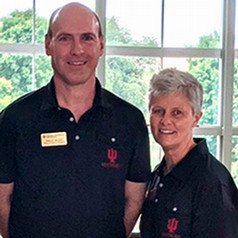Mildred Vernia and Phillip Miller began using an open educational resource textbook and an open courseware platform for a mathematics class that they taught in the fall and spring of 2023 in lieu of a textbook bundle from a major publisher. They wanted to see how these freely available resources compared to the textbooks and courseware that publishers create and that students buy for their courses.

Phillip Miller and Mildred Vernia
Teaching Professors of Mathematics
IU Southeast
Vernia and Miller, who are both teaching professors of mathematics at IU Southeast, walked away impressed. Their data analysis compared the class over several terms with similar variables and found that the changeover resulted in nearly identical student performance. Along the way, the open resources that they used saved students a significant amount of cash. By forgoing a $56 textbook and courseware bundle, their 250 students saved around $14,000 collectively.
Open textbooks are available through digital repositories affiliated with major universities. OpenStax and the Open Textbook Library are two well-known examples. These open textbooks are created by faculty who write them using digital publishing tools. They are made available to students for free in a variety of digital formats. IU eTexts can load open textbooks into the Engage reader at no cost to the student.
Vernia and Miller began thinking about open educational resources when they applied for a Zero Textbook Cost Initiative grant from the IU Southeast Library, which awards cash to faculty who review or adopt no-cost materials. They won the grant for their Finite Mathematics for the Social and Biological Sciences class. Miller has spent 20 years perfecting the course and it has a solid track record of student success. They adopted the Mostly Harmless Statistics open textbook by Rachel Webb and the MyOpenMath open courseware platform for the class.
Since their course is somewhat unique, they needed to create relevant homework questions similar to what they used previously. They began writing their own math problems for students to solve within MyOpenMath. They were able to customize the questions in the open courseware by creating new questions and re-using questions from earlier versions of the class. Miller liked the flexibility of the system.
The (previous) system had some (flexibility), but it would often have its own explanations, and there wasn't an easy way to change these to how you are teaching," notes Miller. "Whereas with this system, since you're essentially writing all the questions yourself, you can write the examples and hints exactly as you want the students to see them.
They compared data from sections with publisher-created materials to those with the open resources. The classes had about the same number of students, were taught equally by each of them, and had a similar mix of face-to-face and online sections.
| Grade | Paid textbook & online homework. N=206. Fall 2022 / Spring 2023 | Zero cost text and open homework. N=186. Fall 2023 / Spring 2024 |
|---|---|---|
A, B, or C | 78.16% 161 students | 77.96% 145 students |
D, W, or F | 21.84% 45 students | 22.04% 41 students |
The data showed that both the sections with the open materials and those with the publisher-created materials had nearly identical pass rates, had similar data for quality of student experience, and had comparable numbers for student mastery of learning outcomes.
I think that the highest praise that we can give about how well it went is that we're both doing it again," Vernia said, noting that they are adopting open textbooks for classes that they will teach in upcoming terms.

